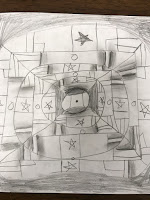First grade is learning about homes in art. We talked about the home life of the early man during the Stone Age, and how they lived without electricity, living off the land and hunting or gathering their food. We talked about how cavemen used to live in caves, and how cave paintings came about before written word. Students then created their own cave paintings on crumbled up brown craft paper.

Then, we jumped to the modern day life, and learned about different style houses and apartments that people live in today. We talked about ranch, tudor, victorian, greek, contemporary, and prairie style homes/apartments. After this discussion, students built a home with wooden cutouts and Popsicle sticks. Next week, they will paint and decorate their homes to make them even more unique.



Second Grade is learning how to create prints in art. We reviewed how to create complex patterns and practiced drawing a couple types of patterns. Students then designed their own print, carving their patterned design into a small piece of styrofoam. They printed this styrofoam stamp over and over again on a colored piece of paper to create an even bigger pattern.
Third grade just finished weaving. They spent weeks warping their loom and weaving the flat textile or purse of their choice. Last week we took them off the cardboard looms and sewed on buttons, tied on handles, glued on googly eyes, or tied on legs and arms, depending on their designs.



Fourth grade just finished their radial symmetry choice projects and are now learning how to create tessellations, a set of shapes that fit together perfectly like a puzzle piece without gaps or overlap. They learned about the artist M.C. Escher and his famous tessellations, and began creating their own tessellations.
Radial symmetry:







M.C. Escher
Fifth graders are moving on from their facial feature projects, and are now learning different water color techniques. This week, students will use these techniques to create the galaxy water color painting of their choice.
Sixth grade is currently working on paper mache sculptures. Students finished building the armature with cardboard newspaper, and tape, and most students finished adding three layers of paper mache paste. Now, students are beginning to paint their large sculptures.



























































No comments:
Post a Comment